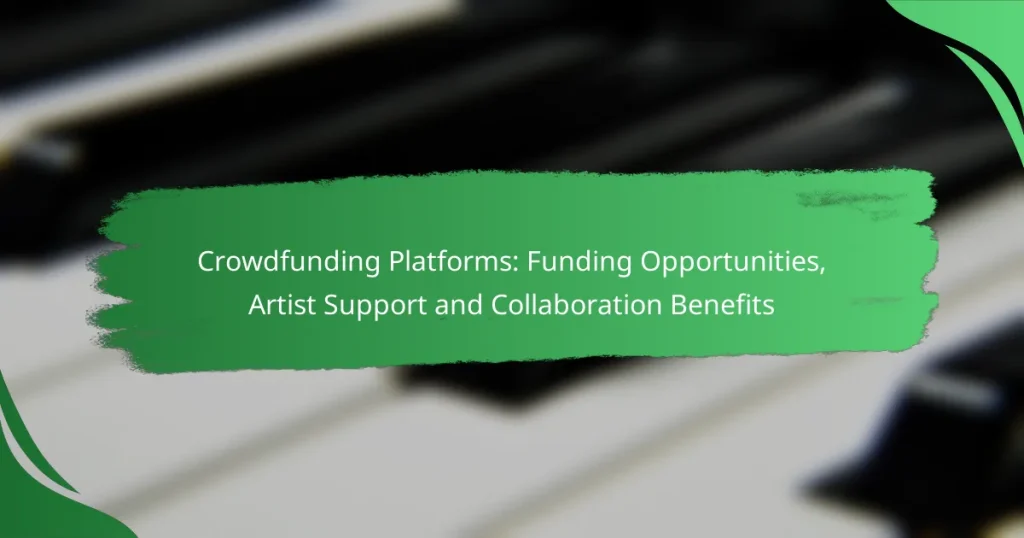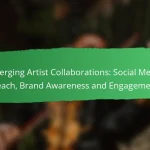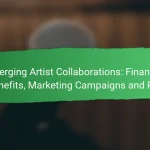Crowdfunding platforms play a crucial role in supporting artists by providing access to funding, community engagement, and promotional opportunities. By connecting directly with their audience, artists can create personalized funding experiences that cater to their unique needs. Platforms like Kickstarter, Indiegogo, and Patreon offer various features that help artists maximize their funding potential and foster collaboration within their creative communities.
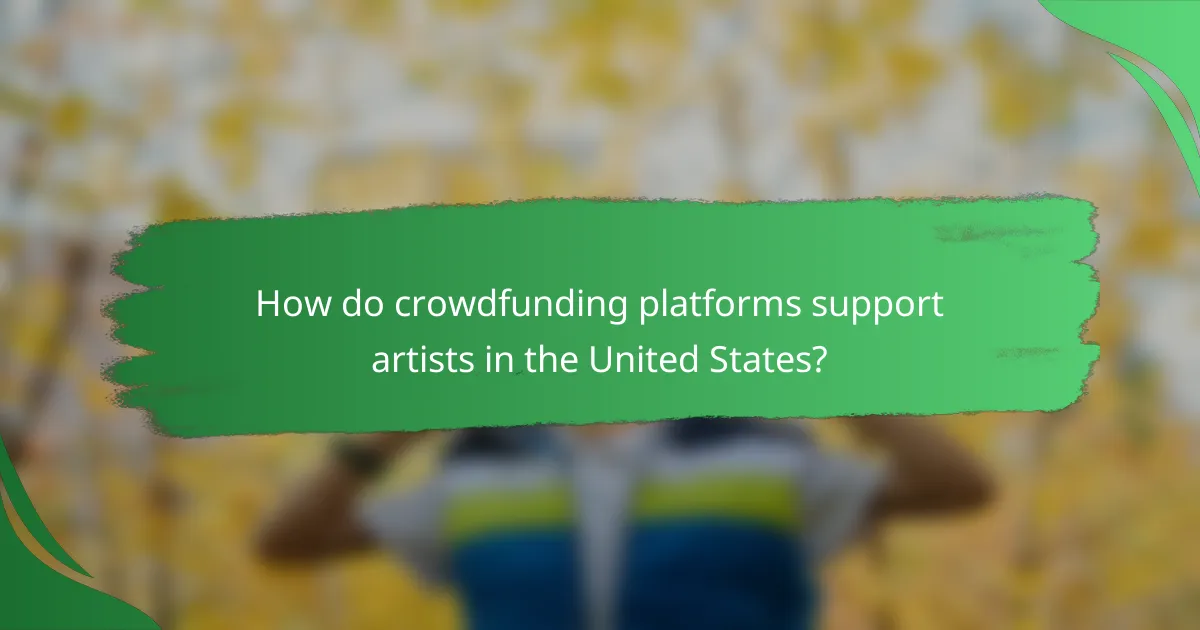
How do crowdfunding platforms support artists in the United States?
Crowdfunding platforms provide essential support to artists in the United States by offering them access to funding, community engagement, and promotional opportunities. These platforms enable artists to connect directly with their audience, allowing for a more personalized funding experience.
Access to diverse funding sources
Crowdfunding platforms allow artists to tap into a wide range of funding sources, including individual backers, small investors, and even grants. This diversity helps artists secure the necessary financial backing for their projects without relying solely on traditional funding methods like loans or bank financing.
Platforms such as Kickstarter and Indiegogo enable artists to set funding goals and offer various reward tiers to incentivize contributions. This approach can lead to funding amounts ranging from a few hundred to several thousand dollars, depending on the project’s appeal and the artist’s network.
Community engagement and networking
These platforms foster community engagement by allowing artists to build a following and connect with supporters who share their interests. Artists can interact with backers through updates, comments, and social media, creating a sense of belonging and collaboration.
Networking opportunities arise as artists engage with their supporters and other creators on the platform. This can lead to collaborations, mentorships, and partnerships that enhance their artistic journey and expand their reach.
Promotion of creative projects
Crowdfunding platforms serve as powerful promotional tools for artists, helping them gain visibility for their projects. By sharing their stories and showcasing their work, artists can attract attention from potential backers and the media.
Successful campaigns often leverage social media and email marketing to amplify their reach. Artists should consider creating compelling visuals and videos to present their projects effectively, as these elements can significantly increase engagement and funding success.
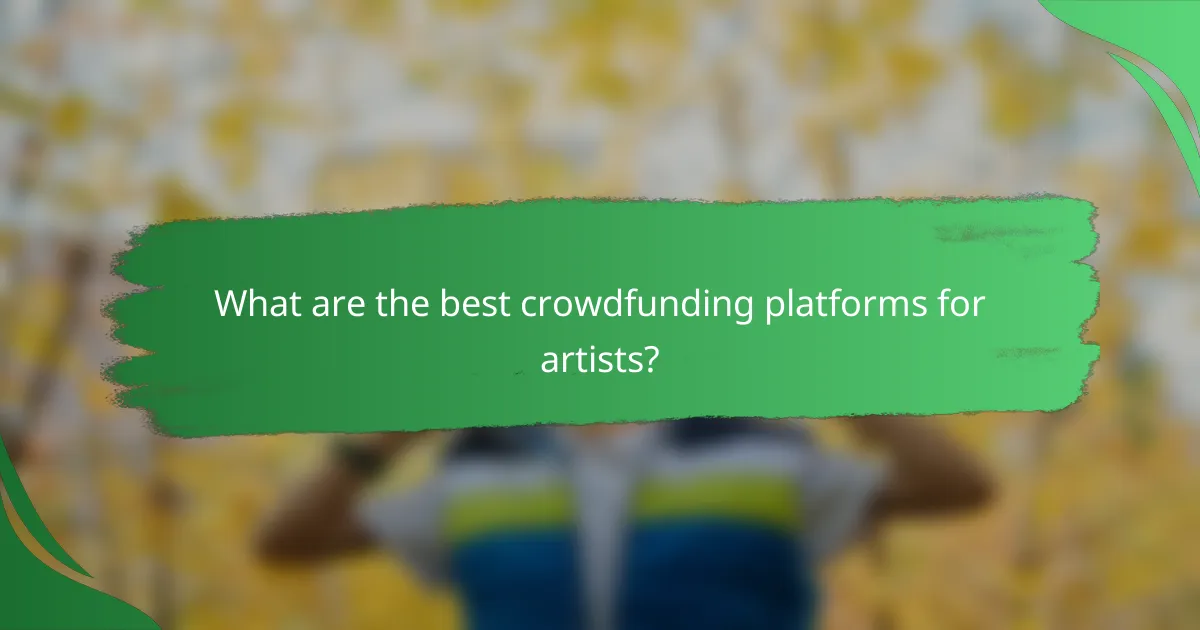
What are the best crowdfunding platforms for artists?
The best crowdfunding platforms for artists include Kickstarter, Indiegogo, and Patreon, each offering unique features tailored to different funding needs. Artists can choose a platform based on whether they seek project-based funding, flexible contributions, or ongoing support from their audience.
Kickstarter for creative projects
Kickstarter is ideal for artists looking to fund specific creative projects, such as films, music albums, or art installations. It operates on an all-or-nothing model, meaning projects must reach their funding goal to receive any money. This approach encourages backers to contribute, knowing their funds will only be used if the project is fully funded.
When using Kickstarter, set a realistic funding goal and timeline. Successful campaigns often offer enticing rewards for backers, such as exclusive merchandise or early access to the project. Keep in mind that Kickstarter charges a fee of around 5% on funds raised, plus payment processing fees.
Indiegogo for flexible funding
Indiegogo offers a more flexible funding model, allowing artists to keep whatever funds they raise, even if they do not meet their goal. This platform is suitable for various creative endeavors, from product launches to artistic projects. Artists can choose between fixed funding (similar to Kickstarter) and flexible funding options.
Consider using Indiegogo if you want to maintain control over your project’s funding. The platform also provides additional features like InDemand, which allows you to continue raising funds after your initial campaign ends. Be aware that Indiegogo takes a fee of around 5% on funds raised, plus payment processing fees.
Patreon for ongoing support
Patreon is designed for artists seeking consistent, ongoing financial support from their fans. It allows creators to offer subscription-based memberships, where supporters can pledge a monthly amount in exchange for exclusive content, behind-the-scenes access, or personal interactions. This model fosters a community around the artist’s work.
When setting up a Patreon, think about the different tiers of membership you can offer. Each tier can provide varying levels of rewards, encouraging fans to contribute more. Keep in mind that Patreon takes a fee of around 5-12% depending on the plan you choose, plus payment processing fees. This platform is particularly beneficial for artists who produce regular content, such as musicians, writers, or visual artists.

How can artists maximize funding opportunities on crowdfunding platforms?
Artists can maximize funding opportunities on crowdfunding platforms by effectively presenting their projects, setting achievable funding goals, and actively engaging with their backers. These strategies not only enhance visibility but also build a supportive community around the project.
Effective project presentation
To attract funding, artists should create a compelling project presentation that clearly communicates their vision. This includes high-quality visuals, a well-crafted video, and a detailed description of the project’s purpose and impact. The presentation should resonate emotionally with potential backers, making them feel connected to the artist’s journey.
Utilizing storytelling techniques can significantly enhance a project’s appeal. Artists should share their personal experiences, challenges, and motivations, which can foster a deeper connection with the audience. Including testimonials or endorsements from previous supporters can also bolster credibility.
Setting realistic funding goals
Setting realistic funding goals is crucial for success on crowdfunding platforms. Artists should assess the total costs involved in their project, including production, marketing, and distribution expenses, and set a funding target that reflects these needs. A common range for initial funding goals is between $5,000 and $50,000, depending on the project’s scope.
It’s important to consider the platform’s fees, which typically range from 5% to 10% of the total funds raised. Artists should also factor in potential currency fluctuations if they are targeting international backers. Setting a slightly lower goal can create a sense of urgency and encourage more backers to contribute.
Engaging with backers
Engaging with backers throughout the crowdfunding campaign is essential for building trust and loyalty. Artists should provide regular updates on the project’s progress, share behind-the-scenes content, and respond promptly to comments and messages. This interaction can help maintain excitement and encourage further contributions.
Offering exclusive rewards for different funding levels can also enhance engagement. These rewards might include early access to the finished product, limited edition merchandise, or personalized thank-you notes. By recognizing and appreciating their supporters, artists can foster a community that is invested in the project’s success.
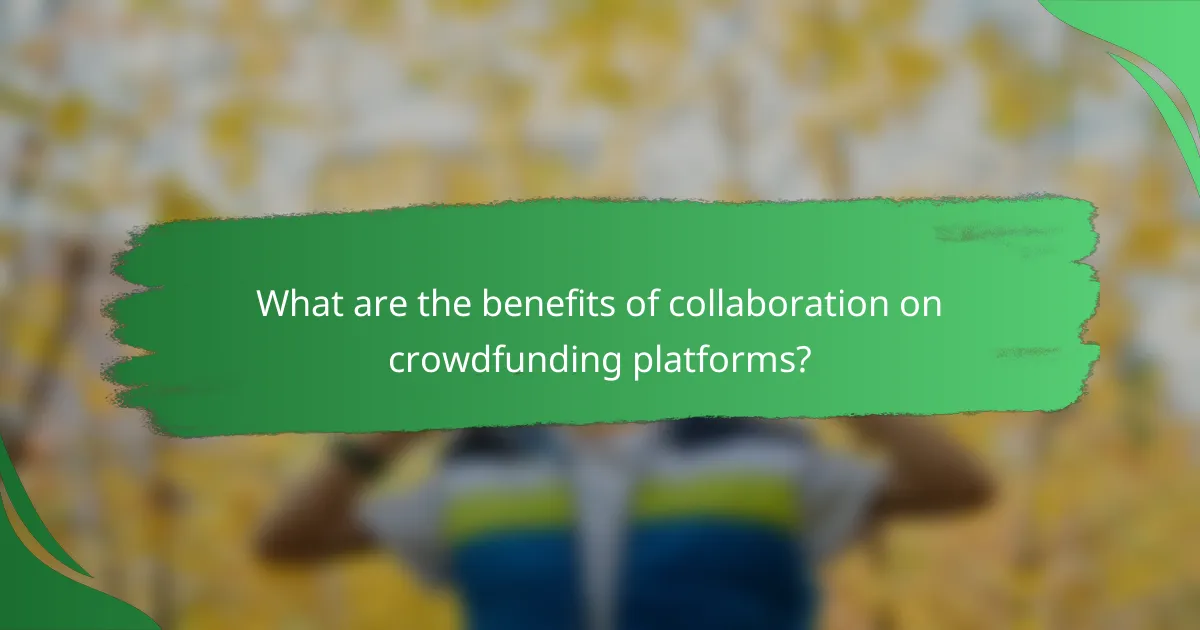
What are the benefits of collaboration on crowdfunding platforms?
Collaboration on crowdfunding platforms offers artists and creators numerous advantages, including access to shared resources, enhanced visibility, and opportunities for cross-promotion. By working together, individuals can amplify their efforts and reach a broader audience, ultimately increasing their chances of successful funding.
Shared resources and expertise
Collaborating on crowdfunding platforms allows artists to pool their resources, such as funding, materials, and skills. This collective approach can lead to more efficient project execution and reduced individual costs. For instance, two musicians might share studio space and equipment, lowering their overall expenses while producing high-quality work.
Additionally, collaboration brings together diverse expertise, enabling creators to learn from one another. A filmmaker might partner with a graphic designer, enhancing the project’s visual appeal while expanding both parties’ skill sets.
Increased visibility and reach
When artists collaborate, they can leverage each other’s audiences, significantly increasing their visibility. Each collaborator brings their own followers, which can lead to a larger potential supporter base for the crowdfunding campaign. This expanded reach can be particularly beneficial for niche projects that may struggle to attract attention on their own.
For example, a writer and an illustrator working together on a graphic novel can promote their project through both of their social media channels, effectively doubling their outreach efforts. This strategy can lead to higher engagement and more backers.
Cross-promotion opportunities
Collaboration opens the door to cross-promotion, where artists can market each other’s work to their respective audiences. This can take various forms, such as sharing each other’s campaign links, featuring one another in promotional materials, or hosting joint events. Such strategies can create a synergistic effect, benefiting all parties involved.
For instance, a musician launching a new album might collaborate with a visual artist to create an accompanying art piece. Both can promote the project through their channels, attracting fans from both fields and increasing the likelihood of funding success.
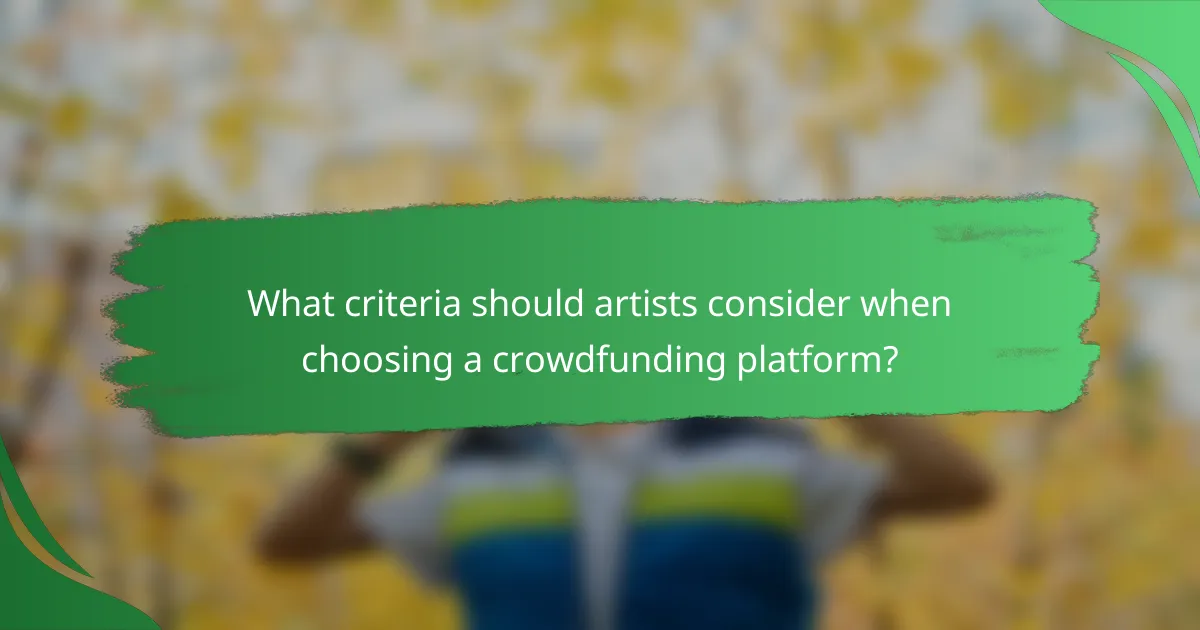
What criteria should artists consider when choosing a crowdfunding platform?
Artists should evaluate several key criteria when selecting a crowdfunding platform, including fee structures, audience demographics, and available features. These factors can significantly impact the success of their funding campaigns and overall experience.
Fee structures and payment processing
Understanding the fee structures of crowdfunding platforms is essential for artists. Most platforms charge a percentage of the funds raised, typically ranging from 5% to 10%, along with payment processing fees that can add another 3% to 5%. Artists should calculate these costs to determine how much they will ultimately receive from their campaigns.
Some platforms offer all-or-nothing funding, where artists only receive funds if they meet their goal, while others allow artists to keep whatever they raise. This decision can affect how much effort artists put into promoting their campaigns.
Audience demographics
Knowing the audience demographics of a crowdfunding platform can help artists target their campaigns effectively. Different platforms attract various user bases, which can influence the likelihood of funding success. For instance, platforms like Kickstarter often appeal to tech enthusiasts and creative projects, while others may cater to niche markets.
Artists should consider where their potential backers are most active and which platforms align with their artistic style and project goals. Researching the platform’s user engagement and success stories can provide valuable insights.
Platform features and tools
The features and tools offered by crowdfunding platforms can greatly enhance an artist’s ability to connect with backers. Essential features to look for include customizable campaign pages, social media integration, and analytics tools to track progress. Some platforms also provide promotional support or community engagement features that can help boost visibility.
Artists should assess whether the platform offers resources like templates, educational materials, or customer support, which can be beneficial, especially for those new to crowdfunding. A well-equipped platform can streamline the campaign process and improve the chances of reaching funding goals.
